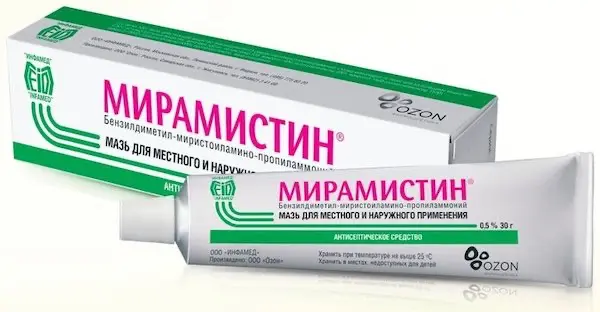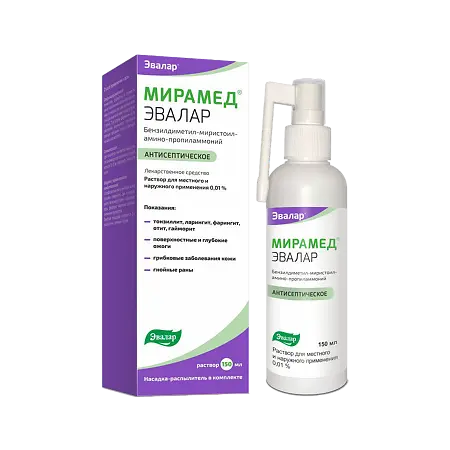Description
Miramistin Pharmacodynamics
Miramistin® contains cationic antiseptic benzildimethyl[3-(myristoylamino)propyl]ammonium chloride monohydrate, due to which it has antimicrobial action against Gram-positive and Gram-negative, aerobic and anaerobic, spore-forming and asphrogenic microflora in the form of monocultures and microbial associations, including hospital strains with multiresistance to antibiotics. The drug is more effective against Gram-positive bacteria (staphylococci, streptococci, etc.). It has antifungal effect on ascomycetes of the genus Aspergillus and Penicillium, yeasts (Rhodotorula rubra, Torulopsis glabrata) and yeast-like (Candida albicans, Candida tropicalis, Candida krusei) fungi, on dermatophytes (Trichophyton rubrum, Trichophyton mentagrophytes, Trichophyton verrucosum, Trichophyton schoenleini, Trichophyton violaceum, Epidermophyton Kaufman-Wolf, Epidermophyton floccosum, Microsporum gypseum, Microsporum canis), as well as other pathogenic fungi (for example, Pityrosporum orbiculare (Malassezia furfur)) as monocultures and microbial associations, including chemotherapy-resistant fungal microflora.
Miramistin® reduces resistance of bacteria and fungi to antibiotics. Due to a wide range of antimicrobial action Miramistin® effectively prevents infection of wounds and burns, activating the regeneration process. The drug has a pronounced hyperosmolar activity, as a result of which it stops wound and perifocal inflammation, absorbs purulent exudate and selectively dehydrates necrotized tissue, promoting formation of dry crust. At the same time, the ointment does not damage granulation and viable skin cells and does not inhibit marginal epithelialization.
Indications
– In surgery – in the 1st phase of the wound process for infected wounds of different localization and genesis (wounds after surgical treatment of purulent foci, decubitus ulcers, purulent post-operative wounds, fistulas); in the 2nd phase of the wound process – for prevention of reinfection of granulating wounds.
– In combustiology – for treatment of superficial and deep burns of II-IIIA degree and frostbite, for preparation of burn wounds for autodermoplasty.
– In dermatology – for treatment of strepto- and staphylodermia, candidiasis of skin and mucous membranes, mycosis of feet and large skin folds, including dyshydrotic forms and forms complicated by pyoderma, smooth skin dermatomycosis.
– For the prevention of complications of wound infection – with non-extensive industrial and domestic injuries.
Contraindications .
Hypersensitivity to the active substance and other ingredients of the drug, pregnancy, breast-feeding, children under 18 years of age (no experience of use).
Administration during pregnancy and breastfeeding
There is insufficient experience in the use of the ointment for the treatment of pregnant women and women during the breast-feeding period.
Directions for use and dosages
- Topically, externally.
- After standard treatment of wounds and burns in adults the ointment is applied directly to the affected area and a sterile gauze bandage is applied or the ointment is applied to a dressing and then to the wound. Tampons impregnated with the drug are loosely filled into the cavity of purulent wounds after surgical treatment. Gauze turundas with ointment are inserted into fistulous passages.
- In treatment of purulent wounds and burns in phase 1 of the wound process the ointment is used once a day, in phase 2 – once a day from one to three days depending on the condition of the wound.
- 2-4 g of ointment (1-2 cm strip) is applied by thin layer on gauze napkins, applying them to wounds with 2-3 cm overlap to undamaged areas around the wound with daily change of bandages. Duration of treatment is determined by the dynamics of wound cleansing and healing. In case of deep localization of infection in soft tissues it is possible to use the drug together with antibiotics of systemic action, and the duration of treatment will be determined by the duration of antibiotic course.
- In treatment of dermatological diseases in adults the drug is applied with thin layer on the damaged skin area several times a day or soaked gauze bandage with subsequent application to the lesion 1-2 times a day until negative microbiological control results are obtained. With widespread dermatomycosis, in particular rubromycosis, the ointment can be used for 5-6 weeks in complex therapy with griseofulvin or antifungal drugs of systemic action.


